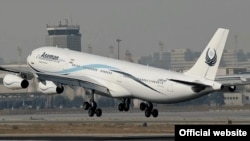While the impact of U.S. sanctions on Iran is deepening week by week, the Islamic Republic's official news agency, IRNA, says, the number of Iranians travelling abroad in the past six months has dropped by 13%, compared with the same period, last year.
Nearly 28 million local and foreign passengers travelled through Iran's airports on 230,000 flights in the past six months, IRNA reported on Friday, october 12.
According to the Ministry of Roads an Urban Development (RUD), the number shows a drop of 13% for internal and 10% for international passengers, compared with the last year [Iranian calendar ending March 20).
Following the dramatic plunge of the value of the national currency, rial, and significant increases in the price of local and international air tickets, demand for air travel has dropped in recent months, in Iran.
Meanwhile, the return of the U.S. sanctions against Tehran in August has forced many western airlines to halt their operations in Iran.
British Airways (BA) suspended its London Heathrow-Tehran service on September 23, leaving Iran Air as the sole operator on the route. BA had argued that the route is no longer commercially viable due to fewer business travellers.
A day later, Dutch airline, KLM also ceased operating the Amsterdam-Tehran route, blaming negative results and financial outlook.
Soon, Air France and Austrian Air also joined their British and Dutch counterparts in leaving the Iranian market.
Nevertheless, RUD's report shows that Iranian airlines, including Iran Air and Mahan Air have not been capable to fill the vacuum left by the European airline.
Based on RUD report, during the past six months, Tehran's old airport, Mehrabad (opened in 1938) was the busiest across the country, with 65,973 flights and relocating 7,665,864 passengers.
Mashhad and Tehran's Imam airports ranked second and third with nearly 35,000 flights, more than five million passengers, 27,569 flights and below 4.5 million passengers, respectively.
Citing experts and analysts, the local news outlets had earlier warned that rising ticket prices and fewer travellers were detrimental to the "existence" of Iranian airlines.
Latest estimates show that 60% to 70% of the operating cost of local airlines are paid with foreign currencies, forcing them to raise ticket prices.
The rise of cost and prices have been "shocking", to the extent that President Hassan Rouhani ordered his officials to try to reduce it.
In the meantime, according to another report, "After strong growth in 2016 and 2017 (following the removal of previous sanctions), Iran-Western Europe seat capacity is set to fall by 30% this winter."





